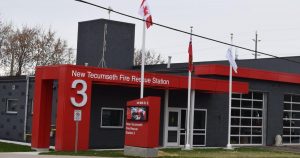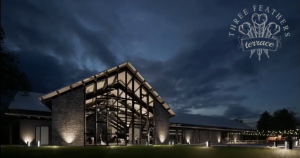Commercial
Some of our Commercial Projects include
- Wholesale Stores
- Restaurants
- Dealerships
- Golf Courses
- Stone and Granite Supplier
- Self Storage Units
- Mechanic Shops
- Your Next Project…call us today!
 New Tecumseth Fire Station
New Tecumseth Fire Station
Station 3
Tottenham, Ontario
Areas of the station where the exposed equipment is stored and washed are identified as hot zones. Areas that are required to be contaminant-free are named cold zones, and the spaces between are transition zones. Architectural hot-zone programming consolidates the spaces within each of the hot and cold zones and provides controlled transitions between the zones. Hot zone design philosophy complements the fundamental fire station design practices of providing the most direct path to respond to an emergency call and grouping similar usage areas.
HVAC systems must support the objective of hot zone design by limiting the transmission of contaminants from the hot zone, through the warm (transition) zone, and into the cold zone. To achieve this goal, the HVAC engineer should view the mechanical systems not as individual components, but as a unified configuration that integrates all aspects of the required building operations.
Contaminant transfer is inhibited and limited by HVAC systems through several means (each may be employed individually or in some combination):
- Positive space pressure control to prevent contaminated air from entering a space. A room can be put into positive pressure by supplying more air than is exhausted. A positive space will move air out of the room, either under the door when the door is closed, or through the doorway when the door is opened. Positive pressure control is typically utilized in cold zones.
- Negative space pressure control to contain contaminated air and prevent transfer to other spaces. A room can be put into negative pressure by exhausting more air than is supplied. A negative space will draw air in from surrounding spaces to make up the differential between the exhaust and supply. The air to make up the exhaust can be transferred under the door, when the door is opened, or through overhead transfer ducts and grilles that connect positive and negative spaces. Negative pressure control is utilized throughout hot zones.
- The 100 percent outdoor air equipment provides a single pass-through of outdoor air that is exhausted without being mixed and returned to the space. This system and equipment type is typically used in all hot zones to remove contaminants. The equipment will be balanced to provide more exhaust than supply so that the space served is under negative pressure.
- Exhaust air from equipment serving hot zones must not be re-entrained into the outdoor air intakes of equipment serving cold zones. This will often require exhaust and intakes to be more than the code minimum distances apart. A good practice is to evaluate local wind direction data.
Click here for a short video of our work at the Tottenham Fire Station
 Three Feathers Terrace
Three Feathers Terrace
Wedding and Event Venue
Innisfil, Ontario
The Three Feathers Terrace was a net-zero project, now this wasn’t our first net-zero project but it was our first commercial one and one we thoroughly enjoyed doing!
A net zero heating and cooling project aims to achieve a balance between the energy consumed and produced within a building’s heating and cooling systems. The goal is to minimize or eliminate the reliance on external energy sources, such as fossil fuels, and instead utilize renewable energy sources to meet the building’s heating and cooling demands.
Components of a net zero heating and cooling project included:
- High-efficiency HVAC systems: Installing advanced heating, ventilation, and air conditioning (HVAC) systems that are energy-efficient and use renewable energy sources.
- Heat recovery systems: Implementing technologies like heat recovery ventilation systems or energy recovery ventilators can capture and reuse waste heat generated within the building for heating or cooling purposes.
- Energy management and controls: Utilizing smart technology and energy management systems to optimize energy use and monitor system performance, making adjustments as needed to achieve energy efficiency.
- Thermal storage systems: Integrating systems like thermal energy storage (TES) allows excess energy to be stored for later use, enabling better management of energy generation and consumption.
Click here for a short video of our work at Three Feathers Terrace.
 Colgan Wastewater Treatment Plant
Colgan Wastewater Treatment Plant
Colgan Crossings Community
Colgan, Ontario
This project is still in progress, check back soon!
Want A Free Quote?
Or if you’d like to receive more information about our products and services
